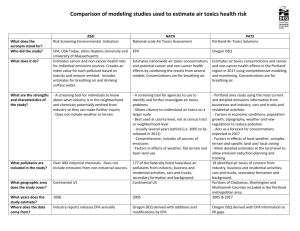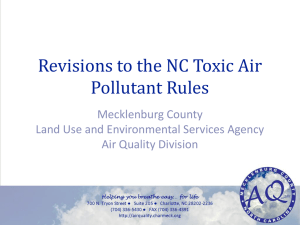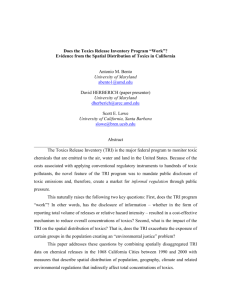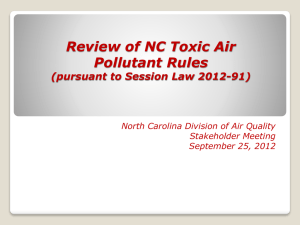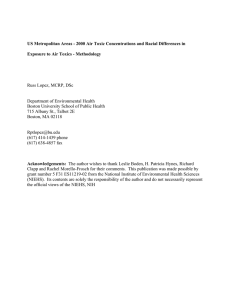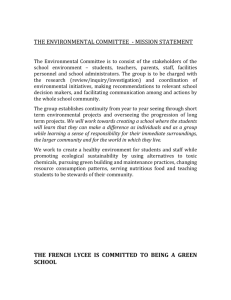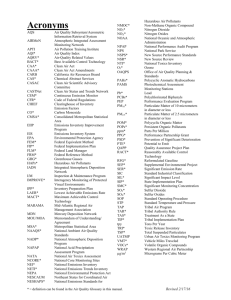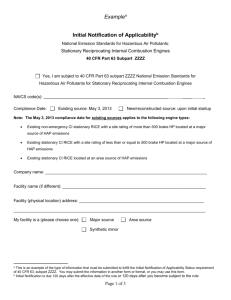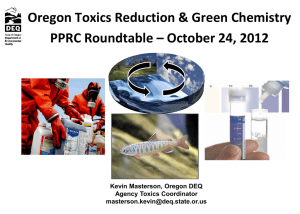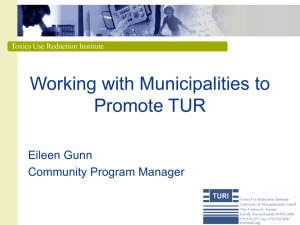mitchell - Air Resources Engineering Center
advertisement
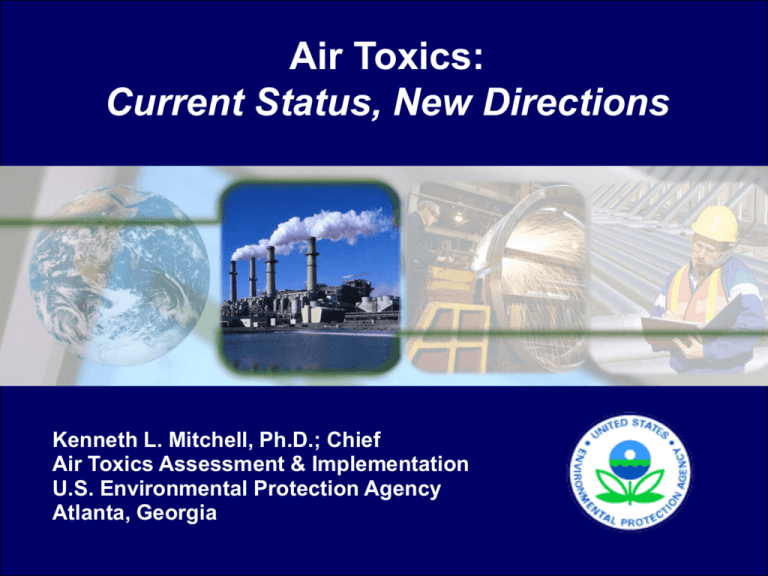
Air Toxics: Current Status, New Directions Kenneth L. Mitchell, Ph.D.; Chief Air Toxics Assessment & Implementation U.S. Environmental Protection Agency Atlanta, Georgia Good Afternoon! • What are Air Toxics? • Program Overview • Current Status • Future Directions What do we mean by “Air Toxics?” Six“Criteria” Pollutants O3, NO2, SO2, Pb CO, PM Mobile Source Pollutants The Federal Clean Air Act 21 Chemicals & Mixtures Hazardous Air Pollutants (Air Toxics) 187 Chemicals & Compounds Why are air toxics a problem? Millions of Sources Cancer Many are Highly Toxic Kidney, Liver Damage Asthma, Chronic Bronchitis Skin Rashes Birth Defects, Miscarriages Developmental Problems in Children Cough, Throat Irritation Nervous System Damage Sources/Populations Colocated Some Persist & Bioaccumulate WIND DIRECTION A B TRANSFORMATION WET DEPOSITION DISPERSION DRY DEPOSITION EVAPORATION/ REENTRAINMENT IN AIR BIOACCUMULATION IN FOOD CANCER TARGET ORGAN/TISSUE INGESTION OTHER NON-CANCER ENDPOINTS EXCRETION INTAKE/UPTAKE DERMAL INHALATION There Are Sources Everywhere! Courtesy of Sustaining the Environment and Resources for Canadians Types of Sources Major Sources Area Sources 10 TPY or more of one HAP Or 25 TPY or more of a combination of HAPS Less than 10 TPY of one HAP Or Less than 25 TPY of a combination of HAPS Types of Sources Outdoor Air Indoor Sources Mobile Sources Not regulated but pose (on average) 3-5 times the concentrations of outdoor air On- and Off-road; Engines, fuels, and operation all contribute to pollution; 21 MSATs THE NATIONAL AIR TOXICS PROGRAM (Stationary, Mobile, and Indoor Air Sources) Regulatory Approaches Risk Assessment Methods for Facility Specific & Community-Scale Risk Decision Criteria for Facilities and Communities Voluntary Reduction Options Education and Outreach Achieve Meaningful Reductions At The Local Level SLT Program Structure Design Residual Risk – Mandate from Congress • Assess risks from stationary sources that emit air toxics after technology-based (MACT) standards are in place • Set additional standards if MACT does not protect public health with an “ample margin of safety” • Set additional standards if necessary to prevent adverse environmental effects Residual Risk – Status • Coke ovens – April 2005 • March 2006 – – – – Industrial cooling towers Magnetic tape Ethylene oxide sterilizers Gasoline distribution • Dry cleaning – July 2006 • HON – December 2006 • Halogenated Solvents – December 2006 Residual Risk – New Directions • Develop “total facility low-risk demonstration (TFLRD)” rule • Develop comprehensive or generic residual risk rule (GRRR) Area Sources – Current Status • The Integrated Urban Strategy was published July 19, 1999 – Identified chemicals of concern – Identified initial list of area source categories • 70 source categories have been listed – Listing completed in November 2002 – Source categories required to be “subject to regulation” – 16 rules completed 20 of the 70 Standards – 4 under court order Area Sources – Recent Additional Court Ordered Schedule • Dec. 15, 2006 4 categories • June 15, 2007 6 categories • Dec. 15 2007* 10 categories • June 15, 2008 10 categories • Dec. 15, 2008 10 categories • June 15, 2009 10 categories 50 Categories *3 area source standards subject to CAA 112(c)(6) (related to PBT chemicals) must be promulgated by this date. Area Sources – Future Directions • National Rulemaking Approach – Establish national standards for source categories that have a national level of concern • Flexible Rulemaking Approach – Enact a rule, covering a set of categories, that will regulate how categories are controlled at the local level based on local needs – EPA will provide guidance on control approaches Mobile Source Air Toxics (MSATs) – Current Status • In March 2001, EPA published first MSAT rule • Toxics emissions performance standard for gasoline – Refinery-specific baselines to ensure no backsliding from 1998-2000 performance • No additional standards for fuels or vehicles • Identified data gaps and committed to additional research • Committed to additional rulemaking to evaluate the need for and feasibility of additional controls Mobile Source Air Toxics – Future Directions • Proposed Rule signed on February 28, 2006 • Public hearing on April 12 • 60-day comment period (through May 30th) • Final rule by February 9, 2007 Mobile Source Air Toxics – Future Directions • Benzene content standard for gasoline • Vehicle standards – Exhaust emissions – Evaporative emissions • Gas can standards Diesel Exhaust – Current and Future Directions • Building on the successes of EPA’s regulatory and voluntary efforts to reduce emissions from diesel engines, EPA has created the National Clean Diesel Campaign (NCDC) – Successful implementation of the 2007 Highway Engine Rule and the Clean Air Nonroad Diesel Rule – Develop new emissions standards for locomotive and marine diesel engines – Promote reduction of emissions for existing diesel engines through costeffective and innovative strategies, including use of cleaner fuels, retrofitting and repairing existing fleets, idling reduction among others Thanks for your attention! Dr. Ken Mitchell U.S. Environmental Protection Agency (404) 562-9065 mitchell.ken@epa.gov http://www.epa.gov/region4/air/airtoxic/index.htm
